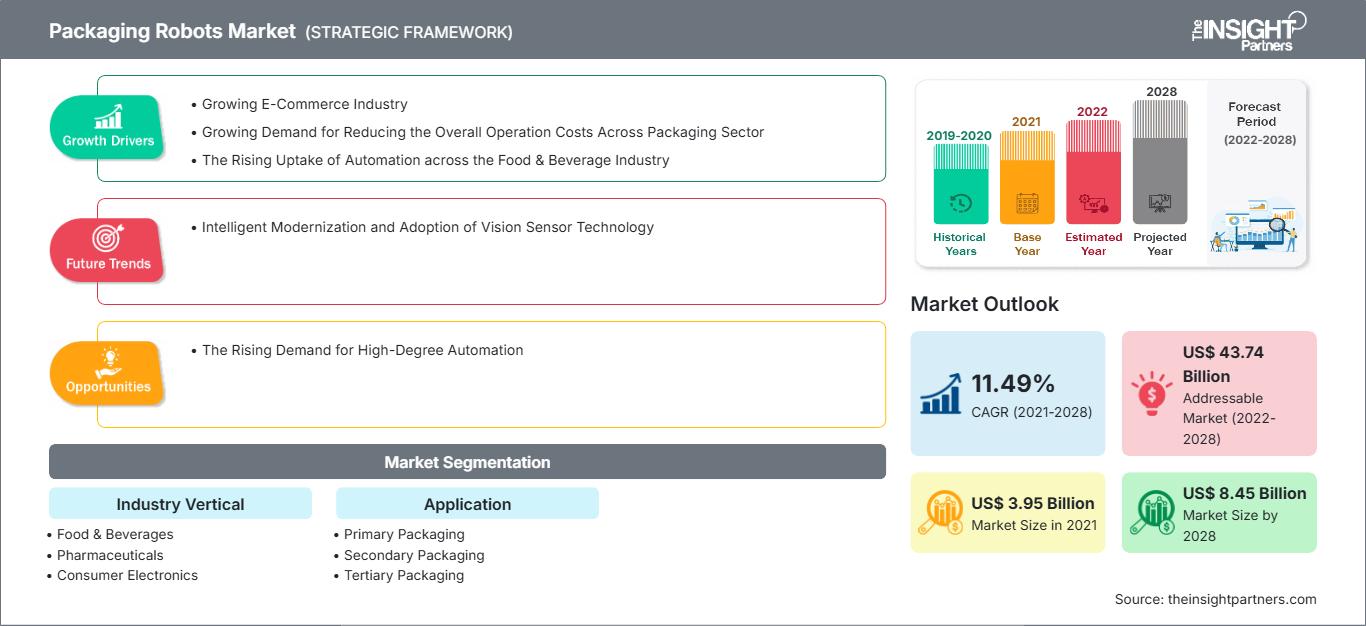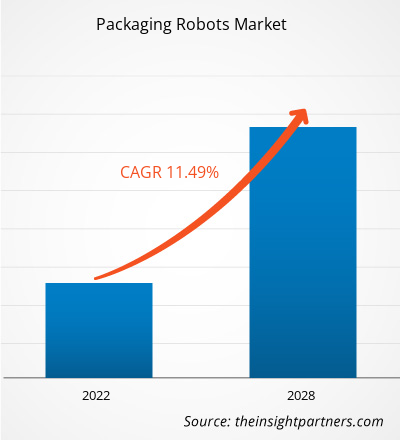[調査レポート] 包装ロボット市場は、2021年の39億4,543万米ドルから2028年には84億4,821万米ドルに成長すると予想されており、2021年から2028年にかけて年平均成長率(CAGR)11.49%で成長すると予測されています。
アナリストの視点:
包装ロボットは、資材搬送作業に正確性、スピード、生産性をもたらすため、多くのメーカーが包装ロボットを導入してスループットを向上させています。また、包装ロボットは一度に多くの製品を持ち上げることができるため、手作業に比べて稼働率がはるかに高く、人件費と全体的な運用コストの削減にもつながり、包装ロボット市場の成長を後押ししています。さらに、食品・飲料業界では、数百ものパッケージやボトルへの充填など、複雑な作業を人間よりも効率的に行う協働ロボットの利用が増加しており、これが包装ロボット市場の成長を牽引しています。また、世界的なeコマース業界の成長も、包装ロボット市場の成長を牽引する要因の一つです。さらに、高度な自動化に対する需要の高まりも、予測期間中に包装ロボット市場の成長機会を生み出すと予想されています。
市場概要:
包装ロボットは、事前に定義された経路に沿って移動し、さまざまな保管場所から物品をピックアップして棚に配置するようにプログラムされたロボットです。これらのロボットは人間の支援なしに動作し、生産ラインを合理化し、人間の介入の必要性を減らすことで時間を節約できます。速度、精度、生産性を向上させることで、様々な産業分野に多くの重要なメリットをもたらし、適切に導入すれば比較的短期間で投資収益率(ROI)を達成できます。エンドオブアームツール(EOAT)に応じて、包装ロボットは様々なタスクを実行できます。包装ロボットは、多くの場合、製品パッケージの開封、充填、搬送、パレット積載、密封、コード化、ラベル貼付を目的として設計されています。これらの利点から、製品の完全性を保つために、製品の正確性、一貫性、高品質が求められる分野で最も広く使用されています。工業分野では、サイクルタイムの短縮と生産性向上のために包装ロボットが広く利用されており、食品・飲料業界でも同様の理由で包装ロボットが使用されています。
要件に合わせてレポートをカスタマイズ
レポートの一部、国レベルの分析、Excelデータパックなどを含め、スタートアップ&大学向けに特別オファーや割引もご利用いただけます(無償)
包装ロボット市場: 戦略的洞察

-
このレポートの主要な市場動向を入手してください。この無料サンプルには、市場動向から見積もりや予測に至るまでのデータ分析が含まれます。
包装ロボット市場の推進要因:
食品・飲料業界全体での自動化の普及が包装ロボット市場の成長を牽引
食品・飲料業界における自動化とは、検査、包装、保管など、さまざまな生産プロセスにわたる技術の統合を指します。長年にわたり、食品・飲料会社は、無人搬送車、デルタロボット、ロボットアームなどの自動化システムを統合することで、さまざまな生産プロセスを最適化し、さまざまな規制機関によって定められた食品の安全性と品質基準に準拠し、生産現場全体の人件費を削減してきました。
さらに、包装された食品や飲料には、高精度で反復的な包装プロセスが求められ、これは人間にとっては課題です。この要因により、一次包装、二次包装、パレタイジングなど、さまざまな活動におけるロボット技術の需要が高まっています。
また、視覚誘導ロボットは、ビンピッキング、ボトルハンドリング、トレイローディングなど、さまざまな反復作業を効率的に完了できるため、食品・飲料業界全体で需要が高まっています。さらに、効率性の向上、トレーサビリティの強化、高い柔軟性など、多くの利点が食品・飲料業界における自動化のニーズを高めています。このような要因により、食品・飲料メーカーは生産施設全体にわたる自動化技術の統合への投資を増やしています。例えば、2021年には、米国を拠点とするスナックブランドであるUtz Brands Inc.が、生産工場全体に自動化ソリューションを統合し、全体的な運用コストを削減する計画を発表しました。同様に、2022年には、Hormel Foodsも生産施設全体に自動化を組み込む計画を発表しました。Tyson FoodsやCargill Inc.などの他の食品・飲料ブランドも、自動化技術の導入に取り組んでいます。このように、食品・飲料業界全体における自動化への投資の増加が、包装ロボット市場の成長を牽引しています。
セグメント分析:
業界別に見ると、包装ロボット市場は食品・飲料、医薬品、家電製品、その他に分類されます。食品・飲料セグメントは2021年に最大の市場シェアを占め、医薬品セグメントは2021年から2028年にかけて最も高いCAGRを記録すると予想されています。食品・飲料業界では、自動化ソリューションの急速な導入が進んでいます。包装ロボットは、品質管理を確保しながら、より迅速な包装を可能にします。また、包装ロボットの導入は作業員の安全性を高め、エンドツーエンドのトレーサビリティによって生産量、廃棄物の削減、人件費の削減が可能になり、生産の柔軟性が向上します。これらのメリットから、様々な食品企業が、食品の安全性と品質基準を確保し、高まる需要に対応するために、ビジョン誘導ロボットアーム、無人搬送車、デルタロボット、高度な検査システムなどを用いてプロセスの最適化に取り組んでいます。そのため、食品および飲料業界では、既存のインフラをアップグレードするために自動化の採用が増えており、それが市場の成長を後押ししています。
地域分析:
アジア太平洋地域では、予測期間中に包装ロボット市場が大幅に成長すると見込まれています。この地域では、中国が2021年に最大の市場シェアを占め、インドは2021~2028年に最高のCAGRを記録する見込みです。生産性の向上とコスト削減を目的とした自動化への投資の増加は、メーカーが高まる消費者需要に対応するのに役立っています。また、ロボットの統合は包装効率の向上と運用コストの削減に役立つため、さまざまな業界での需要が高まっています。さらに、自動化の需要は、この地域で活況を呈しているeコマース業界によって牽引されています。国際航空運送協会(IATA)によると、APACは世界のeコマース市場の成長をリードしており、中国がその成長の大部分を占めています。中国国際貿易局によると、中国の電子商取引市場は世界最大規模であり、世界の取引の約50%を占めています。同様に、アジア太平洋地域の他の国々の電子商取引市場も著しい成長を遂げています。例えば、国際貿易局によると、世界で11番目に大きいeコマース市場であるオーストラリアは、2024年までに323億米ドルに達すると見込まれています。インドブランドエクイティ財団(IBEF)によると、インドのeコマース市場は2025年までに1,880億米ドルに達すると見込まれています。このように、成長する自動化およびeコマース業界が、アジア太平洋地域の市場成長を牽引しています。
主要プレーヤーの分析:
ABB Ltd、Brenton Engineering、FANUC Corporation、Krones AG、KUKA Roboter GmbH、三菱電機株式会社、Remtec Automation LLC、Robert Bosch GmbH、Schnider Electric、およびYaskawa Americaは、主要な包装ロボット市場プレーヤーです。これらの包装ロボット市場プレーヤーは、継続的な製品開発と革新に注力しています。
包装ロボット市場の地域別分析
The Insight Partnersのアナリストは、予測期間を通じて包装ロボット市場に影響を与える地域的な動向と要因を詳細に解説しています。このセクションでは、北米、ヨーロッパ、アジア太平洋、中東・アフリカ、中南米における包装ロボット市場のセグメントと地域についても解説しています。
包装ロボット市場レポートの範囲
| レポート属性 | 詳細 |
|---|---|
| の市場規模 2021 | US$ 3.95 Billion |
| 市場規模別 2028 | US$ 8.45 Billion |
| 世界的なCAGR (2021 - 2028) | 11.49% |
| 過去データ | 2019-2020 |
| 予測期間 | 2022-2028 |
| 対象セグメント |
By 業界分野
|
| 対象地域と国 |
北米
|
| 市場リーダーと主要企業の概要 |
|
梱包ロボット市場のプレーヤー密度:ビジネスダイナミクスへの影響を理解する
包装ロボット市場は、消費者の嗜好の変化、技術の進歩、製品の利点に対する認知度の高まりといった要因により、エンドユーザーの需要が高まり、急速に成長しています。需要が高まるにつれ、企業は製品ラインナップの拡充、消費者ニーズへの対応、そして新たなトレンドの活用を進めており、これが市場の成長をさらに加速させています。

- 入手 包装ロボット市場 主要プレーヤーの概要
最近の動向:
新製品の発売、パートナーシップ、コラボレーション、合併・買収といった無機的・有機的な戦略は、市場の企業に広く採用されています。これらの企業による最近の主要な市場動向をいくつか以下に示します。
- 2023年4月、シェメッシュは化粧品向けのTKS-C60完全ロボット強化包装ラインの発売を発表しました。このラインは、あらゆる形状とサイズの化粧品の供給、充填、キャップ、ラベリング、ケース詰め、パレット積み込みなど、包装プロセス全体を処理するように設計されています。 TKS-C60は、クリームやファンデーションからフレグランスやマニキュアまで、さまざまな製品のボトル詰めラインを毎分60本の速度でシームレスに中断なく実行します。
- 2023年3月、カスタムボトリングおよびパッケージング業界向けオートメーションシステムのメーカーであるProco Machineryは、パッケージング業界で深刻化する労働力不足に対処するため、新しい協働ロボットパッカーの発売を発表しました。この新しいProco協働ロボットパッカーは、人間のオペレーターと協力して効率とパフォーマンスを向上させるように設計されています。この新しいロボットパッカーは、容器のテストからケースへの詰め込みまで、さまざまなタスクを実行できます。
- 2023年2月、Rapid RoboticsはUniversal Robots(UR)との新たなパートナーシップを発表しました。このパートナーシップに基づき、デンマークの協働ロボット(コボット)メーカーであるURは、北米全域にわたるRapid Roboticsのコボット作業セルの展開に協働ロボットアームを提供します。また、ユニバーサルロボットの導入により、ラピッド・ロボティクスはより多くの顧客にサービスを提供できるようになり、全国展開を継続しながらも顧客が期待する迅速な導入時間を維持できるようになります。これらの協働ロボットは、パレタイジング、箱作りと梱包、より重いペイロードやより長いリーチが必要な作業など、多様な機能を備えています。
- 2022年11月、eコマース向けAI駆動型ロボティクスの世界的リーダーであるOSAROは、eコマースおよび物流事業向けのピックアンドプレースロボットシステムの統合を加速するために、SVT Roboticsとの提携を発表しました。SVT Roboticsの画期的なSOFTBOTプラットフォームにより、企業は必要なロボット、自動化、IoTデバイスをわずか数日または数週間で統合および導入できます。この契約の一環として、SVT RoboticsはOSAROのパートナープログラムに参加しました。このプログラムは、フルフィルメント業務にロボットソリューションを導入したい企業にワンストップアクセスを提供します。
- ABBは2022年7月、FlexPicker DeltaロボットポートフォリオにIRB 365を追加すると発表しました。5軸で1.5kgの可搬重量を備えたIRB 365は、クッキー、チョコレート、ピーマン、キャンディー、小瓶、小包などの軽量包装製品の方向転換において、柔軟性とクラス最速性を兼ね備えています。eコマースの増加と、棚にそのまま並べられる包装商品の需要の高まりに対応して、IRB 365は、生産ラインのスピードと適応性が不可欠な食品・飲料、医薬品、消費財などの用途向けに開発されました。
- 過去2年間の分析、基準年、CAGRによる予測(7年間)
- PEST分析とSWOT分析
- 市場規模価値/数量 - 世界、地域、国
- 業界と競争環境
- Excel データセット
最新レポート
お客様の声
購入理由
- 情報に基づいた意思決定
- 市場動向の理解
- 競合分析
- 顧客インサイト
- 市場予測
- リスク軽減
- 戦略計画
- 投資の正当性
- 新興市場の特定
- マーケティング戦略の強化
- 業務効率の向上
- 規制動向への対応






















 無料サンプルを入手 - 包装ロボット市場
無料サンプルを入手 - 包装ロボット市場